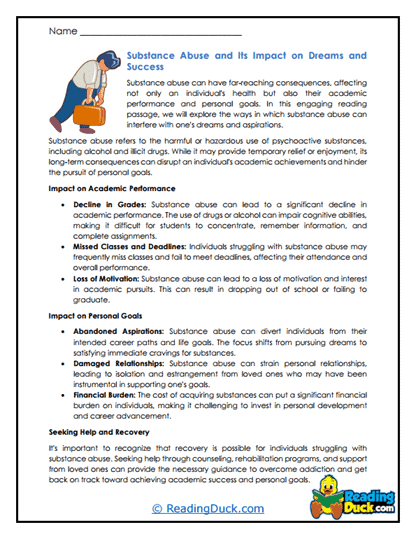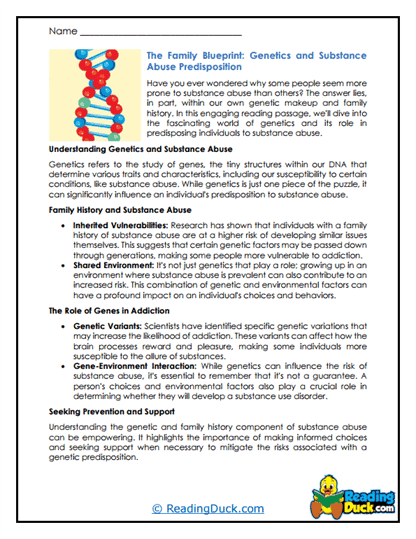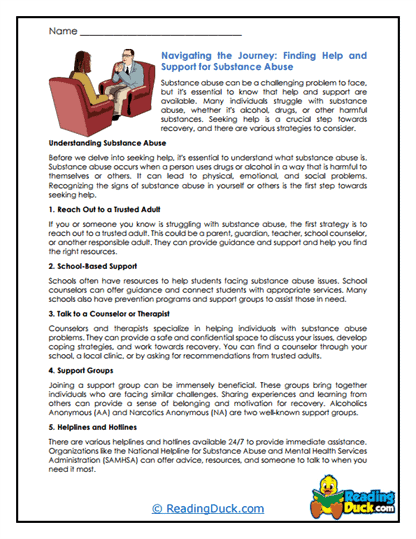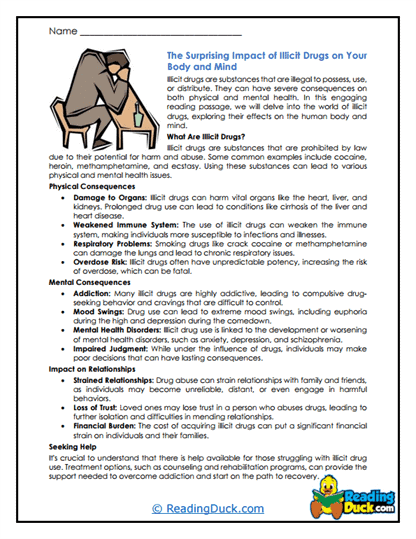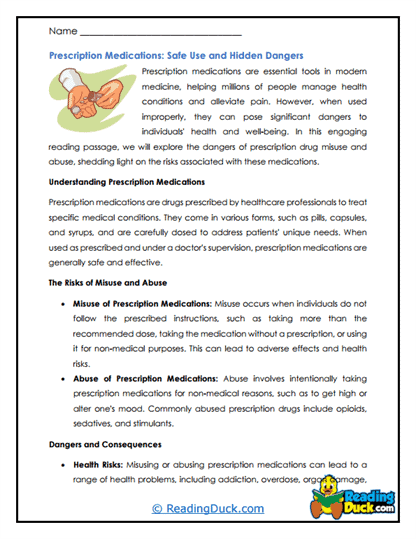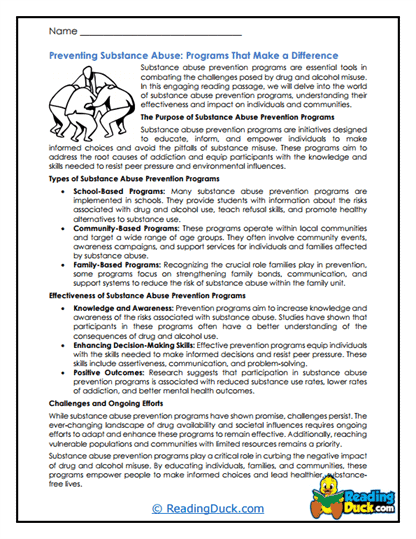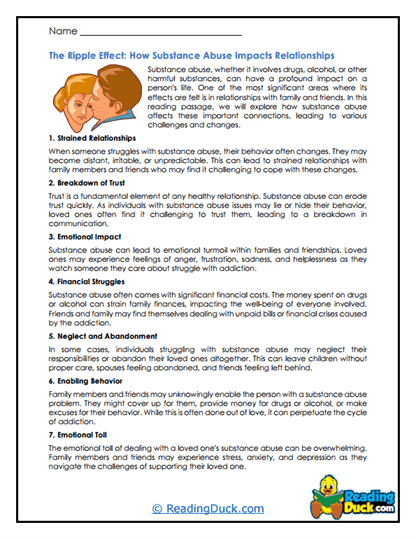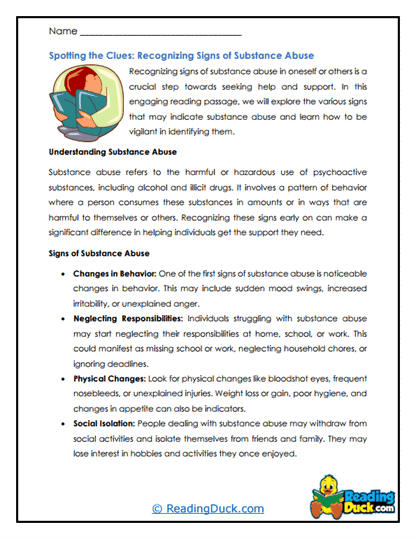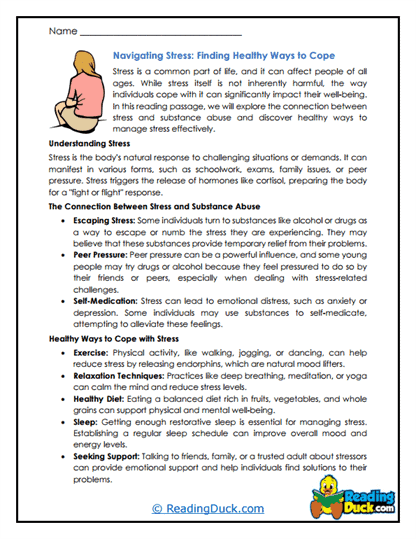Substance Abuse Worksheets
About Our Substance Abuse Worksheets
Our Substance Abuse Worksheets are designed to educate students about the dangers of substance abuse, equipping them with the knowledge and skills needed to make informed decisions and lead healthy lives. Substance abuse is a critical health issue that can have severe consequences on physical and mental well-being. These worksheets go beyond surface-level information, providing students with a deep understanding of the various aspects of substance abuse, its causes, effects, and prevention strategies. As part of the broader Health category, these worksheets align with other important topics such as Alcohol, Eating Disorders, Exercise, Healthy Relationships, Mental Health, Nutrition, Peer Pressure, Personal Hygiene, and Tobacco. These resources are not just about reading—they are about engaging with real-world issues that directly impact students' lives and empowering them to make choices that promote their health and well-being.
This topic contains several worksheet sets, each focusing on a specific aspect of substance abuse. Each worksheet set includes:
- Multiple Choice Questions: These questions assess students' comprehension of the reading passages, focusing on key concepts such as the types of substances commonly abused, the short- and long-term effects of substance abuse, and strategies for prevention and intervention.
- Short Answer Questions: Students are encouraged to provide concise responses that summarize critical information, reflect on the causes and consequences of substance abuse, and analyze scenarios that illustrate the risks associated with substance use.
- Open-Ended Questions: These questions invite students to think critically and express their personal thoughts, opinions, and feelings about substance abuse, encouraging them to explore their values and how they can resist peer pressure and other influences that may lead to substance use.
These worksheets help students demonstrate their understanding of the material while also enhancing their personal connection to it. An answer key is provided for each question sheet, making it easy for teachers and parents to assess student progress. All worksheets are available as PDF files, which can be easily viewed electronically, downloaded, and printed.
Understanding Substance Abuse: The Dangers and Prevention Strategies
Substance abuse is a complex issue that involves the misuse of drugs, alcohol, and other substances, leading to significant health risks and societal problems. Understanding substance abuse is crucial for students as they navigate their adolescent and teenage years when they are most vulnerable to experimentation and peer pressure. These worksheets explore the various facets of substance abuse, providing students with the tools they need to recognize the dangers, resist temptations, and seek help if necessary.
When teaching students about substance abuse, it’s important to cover a variety of key concepts and areas of interest:
- Defining Substance Abuse: Substance abuse involves the harmful or hazardous use of psychoactive substances, including alcohol, illegal drugs, and prescription medications used inappropriately. Students learn about the different types of substances that can be abused and how misuse can lead to addiction, health problems, and social issues. Understanding what substance abuse is helps students recognize the signs of misuse in themselves and others and understand the importance of avoiding such behaviors.
- Types of Substances Commonly Abused: Students explore the various substances that are commonly abused, including alcohol, tobacco, marijuana, prescription medications, and illicit drugs such as cocaine and heroin. They learn about the specific effects of each substance on the body and mind, as well as the risks associated with their use. Understanding the dangers of these substances helps students make informed choices and avoid experimentation.
- The Causes of Substance Abuse: Substance abuse can be driven by various factors, including peer pressure, stress, mental health issues, and a desire to escape from problems. Students learn about the underlying causes of substance abuse, including genetic predisposition, environmental influences, and social factors. Understanding these causes helps students develop empathy for those struggling with substance abuse and reinforces the importance of seeking healthy coping mechanisms.
- The Physical and Psychological Effects of Substance Abuse: Substance abuse can have devastating effects on both the body and mind. Students explore the short-term and long-term effects of substance abuse, including addiction, organ damage, impaired cognitive function, and mental health disorders. They also learn about the social consequences of substance abuse, such as strained relationships, legal issues, and academic failure. Understanding these effects helps students see the far-reaching impact of substance abuse and the importance of avoiding it.
- Recognizing the Signs of Substance Abuse: Early recognition of substance abuse is key to prevention and intervention. Students learn about the physical, behavioral, and emotional signs that may indicate substance abuse, such as changes in appearance, mood swings, and withdrawal from social activities. They also explore the importance of seeking help for themselves or others if they suspect substance abuse. Understanding the signs of substance abuse helps students take proactive steps to address the issue before it escalates.
- The Role of Peer Pressure in Substance Abuse: Peer pressure is a significant factor in the initiation and continuation of substance abuse among adolescents. Students explore how peer pressure can lead to experimentation with substances and the challenges of resisting such pressure. They learn strategies for saying no to substances and finding positive peer influences that support their decision to stay substance-free. Understanding the role of peer pressure helps students build the confidence to make healthy choices in the face of social challenges.
- Prevention and Intervention Strategies: Prevention is the best approach to combatting substance abuse. Students learn about various strategies for preventing substance abuse, including education, building strong support networks, and developing healthy coping mechanisms. They also explore intervention strategies for helping friends or family members who may be struggling with substance abuse, such as offering support, encouraging them to seek professional help, and knowing when to involve trusted adults. Understanding prevention and intervention strategies empowers students to take action to protect themselves and others from the dangers of substance abuse.
- The Importance of Seeking Help: Substance abuse is a serious issue that often requires professional intervention. Students learn about the importance of seeking help if they or someone they know is struggling with substance abuse. They explore the resources available for those seeking help, such as counseling, support groups, and treatment programs. Understanding the importance of seeking help helps students recognize that it’s okay to ask for assistance and that recovery is possible with the right support.
Through these topics, students gain a comprehensive understanding of substance abuse, its effects, and how to prevent it. They learn to appreciate the importance of making informed choices and develop the skills needed to resist peer pressure and seek help if needed.
The Significance of Raising Awareness
Raising awareness about substance abuse is essential, especially as students are at a critical age for developing habits that can have long-lasting effects on their health and well-being. Substance abuse can lead to severe consequences, including addiction, health problems, and social difficulties. By educating students about substance abuse early on, we provide them with the tools they need to make informed decisions and avoid behaviors that could harm their future.
Proficiency in this topic benefits students in several ways. Academically, it helps them stay focused on their studies and avoid the distractions and dangers associated with substance abuse. Personally, it fosters a sense of responsibility for their health and well-being and encourages them to make choices that align with their values and goals. Moreover, it equips students with the knowledge and skills needed to support friends and family members who may be struggling with substance abuse, creating a more supportive and informed community.
How To Use These Worksheets
These Substance Abuse worksheets can be effectively integrated into various subjects and classes, particularly in health education, social studies, and life skills courses. For middle school students, these worksheets introduce the basics of substance abuse, helping them understand the dangers and how to resist peer pressure. For high school students, the worksheets can be used to explore more complex topics such as the causes of substance abuse, the impact of addiction on mental health, and strategies for prevention and intervention. Teachers can also incorporate these worksheets into broader discussions on health, wellness, and decision-making, providing a holistic approach to education that emphasizes the importance of making informed and healthy choices.
Incorporating these worksheets into the curriculum not only reinforces key health principles but also helps students develop essential life skills such as decision-making, empathy, and self-awareness. By engaging with real-world scenarios and questions that require them to apply their knowledge, students build a strong foundation in understanding and preventing substance abuse that will serve them well throughout their lives.
Overall, the Substance Abuse Worksheets provide a comprehensive and engaging way for students to explore the dangers of substance abuse, gain a deeper understanding of its impact on their health and well-being, and develop the skills they need to make informed and healthy choices.
